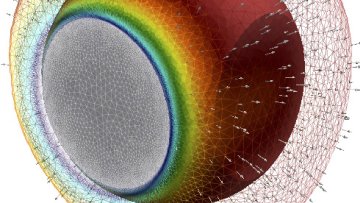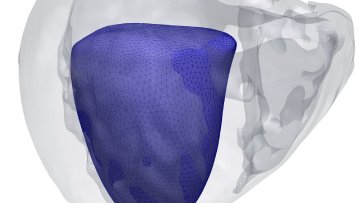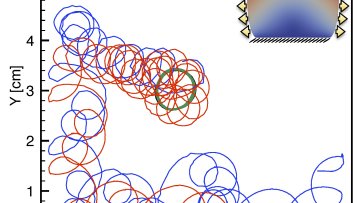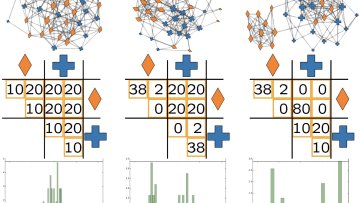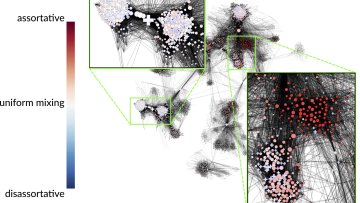Oxford Mathematician Ricardo Ruiz Baier, in collaboration mainly with the biomedical engineer Alessio Gizzi from Campus Bio-Medico, Rome, have come up with a new class of models that couple diffusion and mechanical stress and which are specifically tailored to the study of cardiac electromechanics.
In this collaboration with researchers from the University of Louvain, Renaud Lambiotte from Oxford Mathematics explores the mixing of node attributes in large-scale networks.
Geodesic properties of train track splitting sequences on surfaces
Abstract
TBC
14:00
Co-occurrence simplicial complexes in mathematics: identifying the holes of knowledge
Abstract
In the last years complex networks tools contributed to provide insights on the structure of research, through the study of collaboration, citation and co-occurrence networks. The network approach focuses on pairwise relationships, often compressing multidimensional data structures and inevitably losing information. In this paper we propose for the first time a simplicial complex approach to word co-occurrences, providing a natural framework for the study of higher-order relations in the space of scientific knowledge. Using topological methods we explore the conceptual landscape of mathematical research, focusing on homological holes, regions with low connectivity in the simplicial structure. We find that homological holes are ubiquitous, which suggests that they capture some essential feature of research practice in mathematics. Holes die when a subset of their concepts appear in the same article, hence their death may be a sign of the creation of new knowledge, as we show with some examples. We find a positive relation between the dimension of a hole and the time it takes to be closed: larger holes may represent potential for important advances in the field because they separate conceptually distant areas. We also show that authors' conceptual entropy is positively related with their contribution to homological holes, suggesting that polymaths tend to be on the frontier of research.
12:00
Analysis of contagion maps on a class of networks that are spatially embedded in a torus
Abstract
[[{"fid":"51386","view_mode":"default","fields":{"format":"default"},"type":"media","attributes":{"class":"file media-element file-default"},"link_text":"Barbara Mahler"}]]
12:00
Offset Hypersurfaces and Persistent Homology of Algebraic Varieties
Abstract
We will discuss the algebraicity of two quantities central to the computation of persistent homology. We will also connect persistent homology and algebraic optimization. Namely, we will express the degree corresponding to the distance variable of the offset hypersurface in terms of the Euclidean distance degree of the starting variety, obtaining a new way to compute these degrees. Finally, we will describe the non-properness locus of the offset construction and use this to describe the set of points that are topologically interesting (the medial axis and center points of the bounded components of the complement of the variety) and relevant to the computation of persistent homology.
12:00
Persistent homology and the approximation of intrinsic volumes
Abstract
Persistent homology is an algebraic tool for quantifying topological features of shapes and functions, which has recently found wide applications in data and shape analysis. In the first and introductory part of this talk I recall the underlying ideas and basic concepts of this very active field of research. In the second part, I plan to sketch a concrete application of this concept to digital image processing.
12:00
Which neural codes are convex?
Abstract
This talk focuses on algebraic and combinatorial-topological problems motivated by neuroscience. Neural codes allow the brain to represent, process, and store information about the world. Combinatorial codes, comprised of binary patterns of neural activity, encode information via the collective behavior of populations of neurons. A code is called convex if its codewords correspond to regions defined by an arrangement of convex open sets in Euclidean space. Convex codes have been observed experimentally in many brain areas, including sensory cortices and the hippocampus,where neurons exhibit convex receptive fields. What makes a neural code convex? That is, how can we tell from the intrinsic structure of a code if there exists a corresponding arrangement of convex open sets?
This talk describes how to use tools from combinatorics and commutative algebra to uncover a variety of signatures of convex and non-convex codes.
This talk is based on joint works with Aaron Chen and Florian Frick, and with Carina Curto, Elizabeth Gross, Jack Jeffries, Katie Morrison, Mohamed Omar, Zvi Rosen, and Nora Youngs.
12:00
Multi-parameter Topological Data Analysis
Abstract
How can we adapt the Topological Data Analysis (TDA) pipeline to use several filter functions at the same time? Two orthogonal approaches can be considered: (1) running the standard 1-parameter pipeline and doing statistics on the resulting barcodes; (2) running a multi-parameter version of the pipeline, still to be defined. In this talk I will present two recent contributions, one for each approach. The first contribution considers intrinsic compact metric spaces and shows that the so-called Persistent Homology Transform (PHT) is injective over a dense subset of those. When specialized to metric graphs, our analysis yields a stronger result, namely that the PHT is injective over a subset of full measurem which allows for sufficient statistics. The second contribution investigates the bi-parameter version of the TDA pipeline and shows a decomposition result "à la Crawley-Boevey" for a subcategory of the 2-parameter persistence modules called "exact modules". This result has an impact on the study of interlevel-sets persistence and on that of sheaves of vector spaces on the real line.
This is joint work with Elchanan Solomon on the one hand, with Jérémy Cochoy on the other hand.



